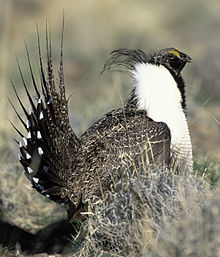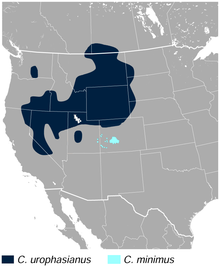Sagehen
| Sage-grouse | |
|---|---|
 |
|
| Adult male greater sage-grouse | |
| Scientific classification | |
| Kingdom: | Animalia |
| Phylum: | Chordata |
| Class: | Aves |
| Subclass: | Neornithes |
| Superorder: | Galloanserae |
| Order: | Galliformes |
| Family: | Tetraonidae (disputed) |
| Genus: |
Centrocercus Swainson, 1832 |
| Species | |
 |
|
| Sage and Gunnison Grouse ranges | |
The sage-grouse are the two species in the bird genus Centrocercus, C. minimus and Centrocercus urophasianus. They are distributed throughout large portions of the north-central and Western United States, as well as the Canadian provinces of Alberta and Saskatchewan.C. minimus is classified as endangered on the International Union for the Conservation of Nature
Males of C. urophasianus are the largest grouse from temperate North America, attaining a maximum weight of 7 pounds (3.2 kg). Adults have a long, pointed tail and legs with feathers to the toes. As in most Galliformes, there is pronounced sexual dimorphism.
The specific epithet is from another Greek word, "oura", plus "phasianos", pheasant. The noun "pheasant" was originally applied to a bird that was native to the valley of the Phasis River (now the Rioni River), which is located in Georgia. In the time of Lewis and Clark the word "pheasant" stood for "a genus of gallinaceous birds", according to lexicographer Noah Webster (1806), and the explorers often used it in that sense. "Gallinaceous" then referred to "domestic fowls, or the gallinae"; the family Galliformes (Latin "gallus", cock, and "forma", shape) now includes pheasants, grouse, turkeys, quail, and all domestic chickens.
...
Wikipedia
